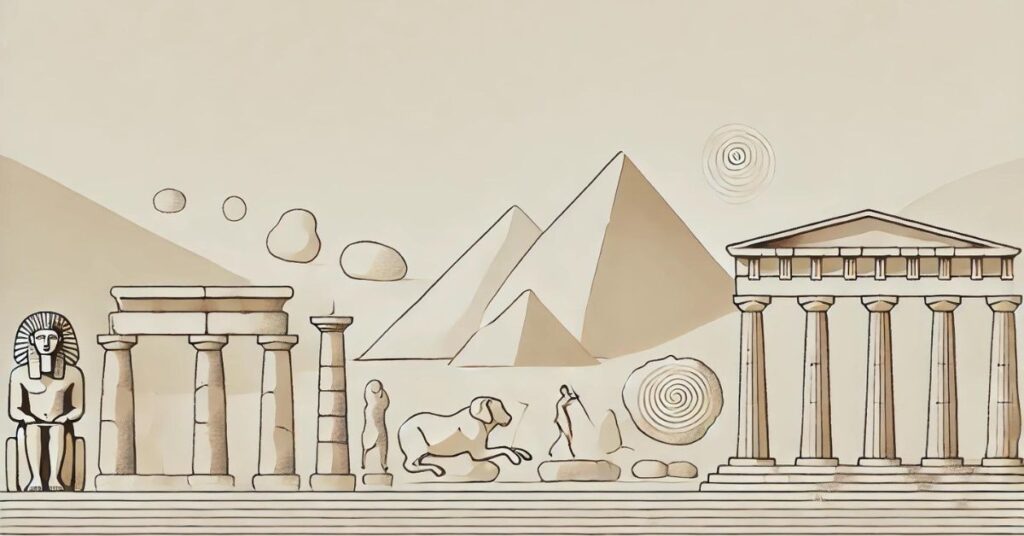Ancient art is one of the earliest forms of human expression. It gives us a glimpse into the lives, beliefs, and cultures of ancient civilizations. From cave paintings to grand sculptures, ancient art shows the creativity and skills of early humans.
This art goes beyond mere decoration. It often had a deep connection to religion, politics, and social order. Ancient art helped communicate important ideas in times when writing systems were limited or not yet developed.
Throughout history, ancient art has been found in all corners of the world. Civilizations like Mesopotamia, Egypt, Greece, and China produced incredible works of art. Each culture had its unique style, but many shared common themes like nature, gods, and rulers.
The materials and techniques used in ancient art were simple but effective. Artists worked with stone, clay, metal, and early forms of paint. Their tools were basic, yet they created pieces that still inspire us today.
One of the most important roles of ancient art was its connection to religion. Art was used in temples, tombs, and shrines to honor gods and guide the dead to the afterlife. The focus on the spiritual made ancient art timeless and meaningful.
In modern times, we still look to ancient art for inspiration. Artists, architects, and historians study these ancient works to learn more about human creativity. Ancient art is a reminder of where we came from and how deeply art has shaped our history.
In this blog post, we will explore the fascinating world of ancient art. We will dive into different cultures, techniques, and iconic pieces. You will discover how ancient art continues to influence modern life and why it remains important today.
| Civilization | Materials Used | Purpose of Art | Famous Examples |
|---|---|---|---|
| Prehistoric | Stone, clay, natural pigments | Religious rituals, hunting symbols | Cave paintings (Lascaux), Venus of Willendorf |
| Mesopotamian | Clay, stone, bronze | Honor gods, kings, document daily life | Ishtar Gate, Stele of Hammurabi |
| Egyptian | Stone, gold, pigments | Religious, funerary, honor pharaohs and gods | Pyramids of Giza, Great Sphinx, Tutankhamun’s Mask |
| Greek | Marble, bronze, stone | Celebrate human beauty, religion, honor heroes | Parthenon, Venus de Milo, Discobolus |
| Roman | Marble, concrete, mosaics | Public monuments, political propaganda | Colosseum, Augustus of Prima Porta, Roman mosaics |
| Chinese | Bronze, jade, pottery | Religious, ceremonial, honor ancestors | Terracotta Army, Shang dynasty bronzes |
| Indian | Stone, bronze, clay | Religious (Hinduism, Buddhism) | Buddha statues, Ajanta Caves murals |
| Mesoamerican | Stone, jade, clay | Religious, calendar, ritualistic | Mayan Calendar Stone, Aztec Sun Stone, Pyramids of Teotihuacan |
| African | Terracotta, wood, bronze | Religious, political, honor ancestors | Benin Bronzes, Nok terracotta figures |
| Southeast Asian | Stone, wood, gold | Religious, ceremonial (Hinduism, Buddhism) | Angkor Wat, Borobudur |
What Defines Ancient Creativity?
Visual Representation of Early Cultures
The creative works of early civilizations capture their culture, beliefs, and daily life. These pieces help us understand how these societies saw their world. Early creativity was an essential way to express identity and convey stories.
Different Mediums and Materials
Early artists used materials that were easily available. Stone, clay, metal, and natural pigments were the most common. These materials were durable, which is why many early works have survived until today.
Purpose of Early Artistic Expression
Early works were not just for decoration. They served many purposes, such as religious rituals, honoring rulers, and celebrating victories. In many cases, art was a way to communicate stories and ideas when writing systems were not yet fully developed.
Common Themes in Early Art
Early creative expressions often focused on nature, gods, and rulers. These themes reflected what was important to early societies. Whether it was a depiction of animals, gods, or kings, their works were used to show power, spirituality, and social order.
Legacy of Early Works
These early creations are more than just historical artifacts. They represent the creative spirit of early humans. Their influence can still be seen today in modern art, architecture, and design, reminding us of the timeless power of human creativity.
A Timeline of Ancient Artistic Achievements
Prehistoric Expressions
Prehistoric times marked the beginning of human creativity. Cave paintings, such as those found in Lascaux, France, are among the most famous examples. These early works often featured animals and symbols, possibly related to hunting and survival.
Mesopotamian Contributions
Mesopotamia is known as one of the first advanced civilizations. Their art focused on gods, kings, and daily life. Notable works include the Ishtar Gate and detailed stone carvings showing scenes of war and peace.
Egyptian Masterpieces
Egypt is famous for its connection to religion and the afterlife. Pharaohs and gods were often depicted in sculptures, tombs, and paintings. The pyramids and the Great Sphinx are lasting symbols of this civilization’s artistic achievements.
Greek Achievements
Greece celebrated human beauty and perfection. Sculptures like the Venus de Milo and buildings like the Parthenon show the Greek mastery of form and balance. Greek artists focused on idealized human figures, often representing gods and heroes.
Roman Innovations
Rome borrowed many ideas from the Greeks but added its own style. The Romans excelled in creating lifelike sculptures and grand public buildings. Famous examples include the Colosseum and intricate mosaics found in ancient Roman homes.
Indian, Chinese, and Southeast Asian Contributions
In India and China, artistic works reflected religious beliefs. Hindu and Buddhist sculptures, along with Chinese bronzes and pottery, were common. Southeast Asia’s Angkor Wat is an example of grand temple art from this region.
African Creativity
African works, especially from ancient Nubia and Egypt, focused on religious and political themes. Terracotta figures and metal sculptures were common forms of expression. These works often represented gods, ancestors, and royalty.
Mesoamerican and South American Contributions
Ancient cultures in the Americas, such as the Mayans and Aztecs, created impressive works. They built pyramids, carved stone sculptures, and made intricate pottery. Many of these pieces were tied to religious rituals and calendars.
This timeline highlights the diversity and richness of early art from various regions of the world. Each civilization contributed to the development of art in unique ways, leaving a lasting legacy that continues to inspire today.
Techniques and Materials in Early Artistic Works
Stone Carving and Sculpture
Stone was one of the most common materials in early creative works. Artists used simple tools to carve statues, monuments, and reliefs. Many famous works, like the Great Sphinx in Egypt and the Greek Kouros statues, were made from stone.
Painting and Pigments
Early artists used natural pigments to create colorful paintings. These pigments came from plants, minerals, and even insects. Cave paintings, like those in Lascaux, used these early forms of paint to depict animals and symbols.
Metalwork and Jewelry
Metals like gold, bronze, and silver were highly prized in early times. Skilled artists crafted jewelry, masks, and ceremonial objects using these materials. The Mask of Agamemnon and Benin Bronzes are examples of early mastery in metalworking.
Pottery and Ceramics
Pottery was essential for both practical and artistic purposes. Cultures like the Greeks and Chinese created beautifully decorated pots and vases. These ceramics often depicted scenes from mythology, daily life, or nature.
Architecture and Monumental Art
Early architecture was another form of artistic expression. Structures like the Pyramids of Giza, Roman Colosseum, and Greek Parthenon were grand artistic achievements. These buildings were designed not only for function but also to reflect the power and beliefs of the culture.
These artists worked with basic materials and tools, but their creativity and craftsmanship were remarkable. Their techniques and materials helped shape the foundation of art as we know it today.
Religious Symbolism in Early Works
Art and Religion
In many early civilizations, art was closely linked to religion. Temples, statues, and paintings were often created to honor gods and goddesses. These works helped people connect with the divine and understand their place in the universe.
Temples and Sacred Spaces
Temples were important centers of worship and were often filled with beautiful art. Structures like the Parthenon in Greece and the Temple of Karnak in Egypt were built to honor the gods. Inside, they were decorated with sculptures, paintings, and carvings that reflected religious beliefs.
Funerary Art
Funerary works played a key role in ancient burial practices. In Egypt, tombs were decorated with paintings and sculptures to guide the dead in the afterlife. Similarly, the Terracotta Army in China was created to protect Emperor Qin Shi Huang in his journey after death.
Symbolic Motifs
Early creativity was full of symbolic imagery. Animals, plants, and mythological figures were often used to represent spiritual ideas. For example, the Eye of Horus in Egyptian art symbolized protection, while the lotus flower in Indian art represented purity and rebirth.
Ritual Objects
Many early works had practical uses in religious rituals. Items like Greek vases, Mayan altars, and African masks were often used in ceremonies. These objects not only served a functional purpose but also held deep spiritual meaning.
Religious symbolism was at the heart of much of early artistic expression. These works helped express the beliefs and values of early civilizations, making them powerful tools for connecting with the sacred.
Iconic Examples of Early Artistic Masterpieces
Venus of Willendorf
The Venus of Willendorf is a small prehistoric statue believed to represent fertility. This stone figure dates back over 25,000 years. It is one of the earliest known examples of human sculpture.
The Palette of Narmer
The Palette of Narmer is an ancient Egyptian artifact that shows the unification of Upper and Lower Egypt. This carved stone dates back to around 3000 BCE. It is a key piece of Egyptian art and history, highlighting the importance of pharaohs.
Parthenon Sculptures
The sculptures of the Parthenon in Athens are famous examples of classical Greek art. These marble figures show gods, goddesses, and scenes from Greek mythology. They reflect the Greek ideals of beauty, balance, and harmony.
Terracotta Army
The Terracotta Army consists of thousands of life-sized clay soldiers found in the tomb of China’s first emperor, Qin Shi Huang. These statues were created to protect the emperor in the afterlife. Each figure is unique, showing the craftsmanship and attention to detail of ancient Chinese artists.
Mayan Calendar Stone
The Mayan Calendar Stone, also known as the Sun Stone, is a large circular carving from ancient Mesoamerica. It reflects the Mayan understanding of time and the cosmos. This stone is a symbol of the Mayans’ advanced knowledge of astronomy and their artistic skill.
These iconic examples represent the creativity and innovation of early civilizations. They continue to inspire and fascinate people today, showing the lasting impact of ancient artistry.
The Influence of Early Artistic Works on Modern Creativity
Neoclassicism
Ancient Greek and Roman art had a major influence on the Neoclassical art movement. This style became popular in Europe during the 18th and 19th centuries. Artists and architects borrowed techniques like symmetry, balance, and idealized forms from the classical era.
Modern Architecture
Many modern buildings are inspired by ancient architectural styles. Columns, domes, and arches found in early temples and public structures can be seen in government buildings, museums, and universities today. For example, the U.S. Capitol and the British Museum are both designed with elements from ancient Greek and Roman architecture.
Art Revivals in Popular Culture
Ancient art often makes a comeback in modern popular culture. Movies, video games, and fashion frequently take inspiration from early civilizations. Films like Gladiator and video games like Assassin’s Creed showcase the styles and stories of ancient Rome, Egypt, and Greece.
Influence on Sculpture
Modern sculptors are still inspired by the idealized human figures of ancient Greece and Rome. Artists like Auguste Rodin took inspiration from classical forms and techniques. Contemporary sculptures often reflect the same attention to human anatomy and movement seen in early art.
Abstract and Minimalist Art
Some forms of early creativity, like African and Pre-Columbian art, influenced modern abstract and minimalist movements. Artists such as Pablo Picasso and Henry Moore were inspired by the simplicity and bold forms of ancient sculptures. These ancient works continue to inform the direction of modern art.
The influence of ancient art is still visible in modern times, shaping the way we create and appreciate art. From architecture to sculpture, ancient techniques and ideas continue to inspire new generations of artists.
Preserving Early Masterpieces
Challenges of Preservation
Preserving early masterpieces is difficult because many pieces are thousands of years old. Exposure to weather, pollution, and human activity can damage these fragile works. Looting and illegal trade also threaten the survival of ancient artifacts.
Restoration Efforts
Restoration projects help repair and protect these valuable works. Famous examples include the restoration of the Sistine Chapel in Italy and the Great Wall of China. Skilled experts use careful techniques to restore damaged pieces while preserving their original appearance.
Role of Museums
Museums play a key role in preserving these ancient creations. Institutions like the British Museum and the Louvre house large collections of ancient art from around the world. These museums work to protect, display, and educate the public about these valuable pieces.
Digital Preservation
Modern technology is helping preserve ancient creations in new ways. Digital scanning, 3D modeling, and virtual reality allow people to explore and study ancient art without risking damage to the original pieces. These technologies also make these works more accessible to people worldwide.
Ethical Considerations
There are ongoing debates about the ownership of early works. Many artifacts were taken from their countries of origin during colonial times. Today, some nations are requesting the return of these pieces to their homeland, raising important ethical questions about preservation and ownership.
Preserving ancient works ensures that future generations can learn from and appreciate the achievements of early civilizations. With modern techniques and ethical awareness, we can protect these cultural treasures for the years to come.
Discovering Ancient Masterpieces Today
Museums and Galleries
Many of the world’s greatest museums have extensive collections of ancient works. The Metropolitan Museum of Art in New York, the Louvre in Paris, and the British Museum in London display treasures from early civilizations. Visiting these museums gives people a chance to see these works up close.
Archaeological Sites
You can also discover these ancient masterpieces by visiting archaeological sites. Famous locations like Pompeii in Italy, Luxor in Egypt, and Machu Picchu in Peru offer a firsthand view of early cultures. These sites are often open to the public and offer guided tours to explain their significance.
Virtual Tours
For those who can’t travel, virtual tours provide a great way to explore ancient works from home. Many museums and archaeological sites now offer online experiences. You can take a virtual tour of the British Museum’s Egyptian exhibit or explore the Terracotta Army in China without leaving your home.
Books and Documentaries
There are many books and documentaries that explore early creative achievements. Some focus on specific civilizations, while others provide an overview of art across different cultures. Watching documentaries or reading about these works is a great way to deepen your understanding and appreciation.
Engaging with Early Art Online
Social media and websites now make ancient works more accessible than ever. Instagram accounts dedicated to art history and online platforms like Google Arts & Culture allow users to engage with ancient creativity in a modern way. This helps spark interest in ancient cultures and educates new audiences.
Discovering ancient art today is easier than ever. Whether through museums, archaeological sites, or online resources, people can explore the beauty and history of ancient civilizations from anywhere in the world.
Conclusion
The Lasting Impact of Ancient Creativity
The creations of early civilizations have shaped the way we understand human history and culture. They show us how early societies expressed their beliefs, values, and creativity. Even today, the beauty and complexity of these works continue to inspire people around the world.
A Connection to the Past
Through these early creations, we can connect with people who lived thousands of years ago. Their works allow us to see how they viewed their world and what was important to them. This connection helps us appreciate the similarities and differences between our lives and theirs.
The Importance of Preservation
Preserving ancient works is crucial for future generations. By protecting these treasures, we ensure that people can continue learning from and enjoying them. As modern technology advances, we have more tools to help preserve these works while making them accessible to everyone.
Ancient creativity is a window into the past that still has a powerful influence on our present. By exploring and preserving these works, we honor the creativity and legacy of the early civilizations that shaped our world.
FAQs
1. What is ancient art?
Ancient art refers to the visual works created by early civilizations, often dating back thousands of years. This includes sculptures, paintings, pottery, architecture, and other forms of creative expression that were made before the fall of the Roman Empire or the end of the classical period.
2. Why is ancient art important?
Ancient art is important because it offers insights into the cultures, beliefs, and daily lives of early civilizations. It also serves as a record of human history and creativity, reflecting how societies evolved and interacted with their environment and each other.
3. Which civilizations are known for their contributions to ancient art?
Some of the most notable civilizations include Ancient Egypt, Mesopotamia, Greece, Rome, China, India, and the Mayan and Aztec cultures. Each of these civilizations produced unique artistic works that have had a lasting impact on history.
4. What materials were used in ancient art?
Artists in ancient times commonly used stone, clay, metal, wood, and natural pigments. These materials were readily available and durable, allowing many pieces to survive for thousands of years.
5. What is the purpose of ancient art?
Ancient art served various purposes, including religious, political, and practical functions. It was used to honor gods, commemorate rulers, celebrate victories, and represent everyday life. Art also had a significant role in burial rituals and temples.
6. How does ancient art influence modern art?
Ancient art has had a major influence on modern art, particularly in architecture, sculpture, and design. Neoclassicism, for example, was heavily inspired by the artistic styles of Ancient Greece and Rome. Even today, elements of ancient art can be seen in contemporary works and public buildings.
7. Where can I see ancient art today?
Ancient art can be seen in major museums around the world, such as the Louvre in Paris, the British Museum in London, and the Metropolitan Museum of Art in New York. Archaeological sites like Pompeii and the Pyramids of Giza also offer direct access to ancient artistic works.
8. What are some famous examples of ancient art?
Some famous examples include the Venus of Willendorf, the Palette of Narmer, the Parthenon Sculptures, the Terracotta Army, and the Mayan Calendar Stone. These iconic works represent the height of artistic achievement in their respective cultures.
9. How is ancient art preserved?
Preserving ancient art involves careful restoration efforts, museum protection, and modern digital technologies like 3D scanning. Preservation also includes ethical considerations, such as ensuring that artifacts remain in or return to their countries of origin.
10. Can I visit ancient art sites virtually?
Yes, many museums and archaeological sites offer virtual tours. Websites like Google Arts & Culture and museum websites allow you to explore ancient artifacts and historical sites from the comfort of your home.
11. What role did religion play in ancient art?
Religion was a major influence on ancient art. Many works were created to honor deities, tell religious stories, and guide the dead in the afterlife. Temples, shrines, and religious symbols were central themes in the art of many ancient cultures.
12. What are some challenges in preserving ancient art?
Preservation challenges include environmental damage, pollution, illegal looting, and the natural decay of materials over time. Additionally, disputes over the rightful ownership of ancient artifacts taken during colonial periods add complexity to their preservation and display.







